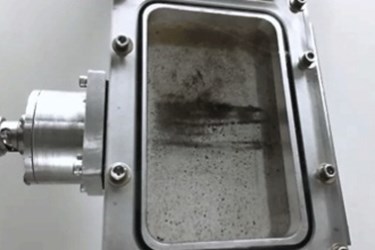Acoustic Technique Presents Fresh Take On Water Treatment

Technology could solve longstanding problem of separating suspended contaminants from water
When oil and gas are extracted from the earth, water also comes to the surface. Known as produced water, it contains naturally occurring hydrocarbons, salt, bacteria, radioactive material and other compounds, as well as any chemical additives used to ease extraction.
Each year, the U.S. alone generates more than 21 billion barrels (approximately 900 billion gallons) of produced water from oil and gas extraction, including hydraulic fracturing. To treat this water before disposal or reuse, the industry depends on filtration and separation technologies.
Typically, dispersed particles or droplets are removed from a host liquid using a series of complex techniques. These techniques are energy--intensive and may require the addition of chemicals to work. They have also proven inefficient at removing the tiniest oil droplets and contaminants.
With funding from the National Science Foundation (NSF), FloDesign Sonics, a small business based in Wilbraham, Massachusetts, has developed a new, efficient separation technology that can help clean produced water. The company's design uses acoustic waves to continuously capture and separate substances from water or other liquids without using filters or chemicals.
FloDesign Sonics demonstrated their separation technology at the White House Water Summit March 22.
Sound separation
At the heart of FloDesign Sonics' system is a method called acoustophoresis, in which droplets or particles within a liquid can be manipulated with a special acoustic wave pattern. The new system uses a pattern of ultrasonic waves in the megahertz range.
The wave pattern exerts acoustic forces that bind substances dispersed in the liquid into clusters. Depending on their relative density compared to the liquid, these larger clusters either settle to the bottom or rise to the surface, where they can be separated easily.
"Acoustophoresis has been used primarily in microfluidics and other micro-scale systems," explained Jason Dionne, co-founder and senior engineer of FloDesign Sonics. "When the U.S. Army was looking for a technology for rapid detection of anthrax spores in large bodies of water, we got the idea to develop an acoustic separation technology that works at the macroscale."
FloDesign Sonics' patented system, called Acoustic Wave Separation (AWS), was designed to treat produced water from hydraulic fracturing (fracking) operations that extract natural gas. The amount of produced water generated at a fracking site changes over the lifetime of the well and depends on the geologic formation, but can reach 100,000 gallons per day.
"It's challenging for current technologies to remove particles smaller than 20 microns without the addition of chemicals," Dionne said. "AWS separates particulates, oil droplets, sand and bacteria as small as 1 micron."
Produced water treated with the AWS system meets or exceeds the Environmental Protection Agency's standards for safe discharge.
"With NSF funding, we have scaled up our technology to an industrially relevant scale," Dionne said. "We now have a 7,000 -gallon per day prototype that we are ready to pilot with a partner. The ultimate goal for our technology within the oil and gas industry is to build a system capable of processing 100,000 gallons per day.
Dionne said that compared to current methods for treating produced water, the AWS system would reduce energy and chemical usage by up to 75 percent.
Beyond oil and gas
FloDesign Sonics' proprietary technology has potential for separations in many sectors beyond oil and gas. One sector showing special promise is life science. Not only is the technique gentle on living cells, which can be damaged when separated by traditional methods, it also is able to separate particles of any size, overcoming a limitation of current filtration techniques.
The company can picture the technology being used one day for cleaning and transfusing a patient's own blood during surgery.
In the nearer term, acoustic wave separation may be used to recover biological products from mammalian cells, which requires a purification process with high yield, product consistency and reproducibility.
In April 2016, FloDesign Sonics will introduce its first product, a system that harvests therapeutic proteins and antibodies for biopharmaceutical manufacturing. Later in 2016, the company will introduce a second product, designed for continuous production of proteins from mammalian cell cultures.
The company is currently investigating applications in the growing field of cell and gene therapies.
Acoustic wave separation technology was developed with $1.6 million in NSF funding through the Small Business Innovation Research (SBIR) program. FloDesign Sonics currently holds nine patents and has raised more than $25 million of private sector funding. The company has grown from one employee in 2012 to 28 full-time employees today.
"FloDesign Sonics' research has led to an elegant and efficient method to accomplish difficult separations, which could impact a broad spectrum of manufacturing and production processes," said Prakash Balan, a program director for the NSF SBIR program. "NSF invests in small businesses like FloDesign Sonics to help promising high-tech concepts make it to the marketplace."
Read more about FloDesign Sonics' technology for biopharmaceutical manufacturing in the September 2015 edition of CEP Magazine.
Source: The National Science Foundation
